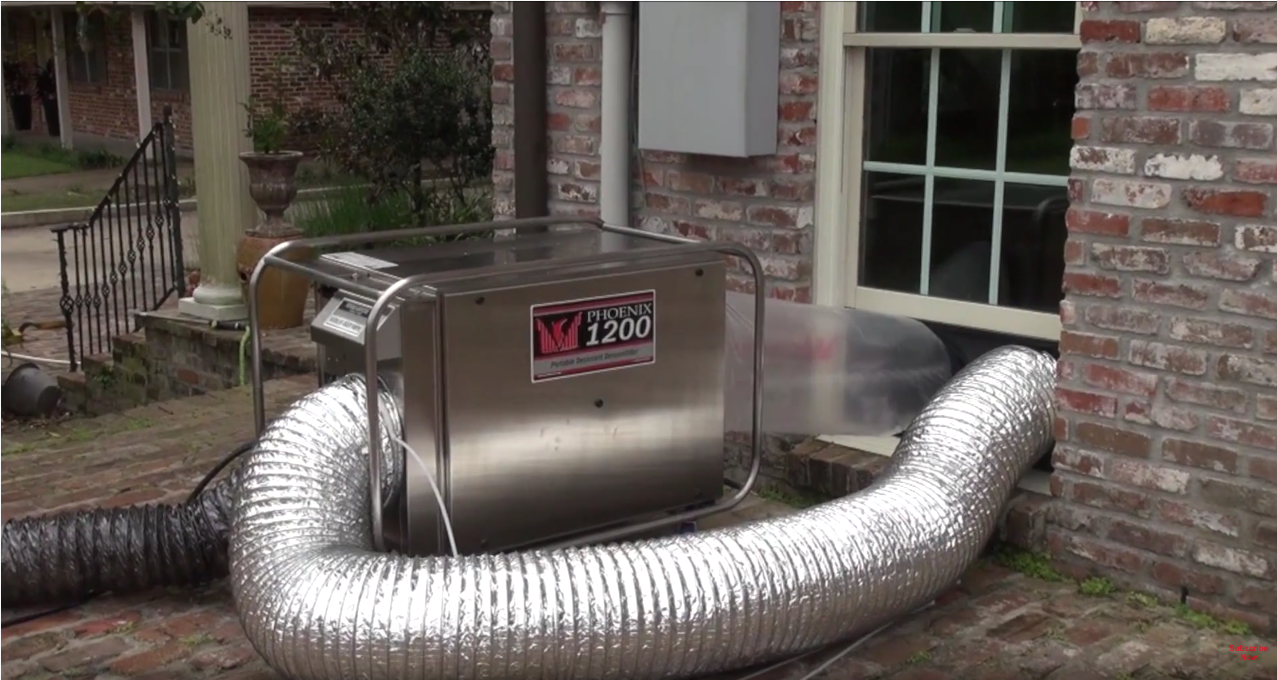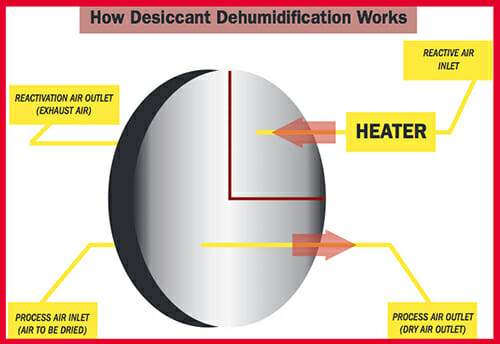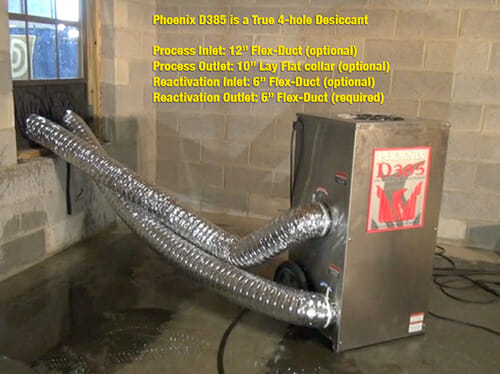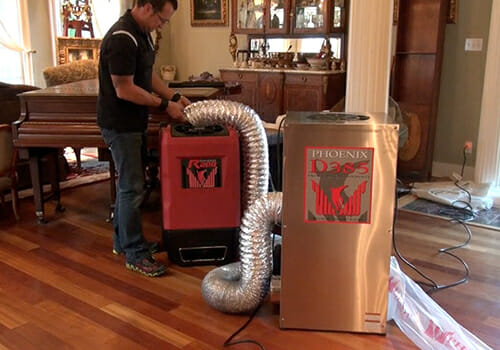
How to Dry Using Desiccant Technology
Desiccants — What They Are and How They Do It
Desiccant dehumidifiers have become an important tool for many restoration contractors. While the majority of the dehumidifiers in a company’s equipment fleet are often LGRs, desiccants offer some unique performance features that make them better suited to some specific drying situations. The primary distinction between desiccants and refrigerant-based dehumidifiers is in how they remove the water and the exceptionally dry air desiccants can produce.
The typical desiccant dehumidifiers used in restorative drying are capable of drying air to single-digit grains per pound (GPP) levels, which is about 4%RH at 70°F. These are dew points several degrees below freezing. LGRs under the best situations cannot dry areas below a 32°F dew point; therefore desiccants can create a much drier environment.
Restoration desiccants dehumidify the air by exposing the moist air to a desiccant material that adsorbs moisture. This moisture is then removed from the desiccant and expelled in the form of water vapor from the desiccant dehumidifier. There are two air flow paths through separate sealed chambers. The first path is the air to be dried; referred to as the process air, and the second is the regeneration or reactivation air that exhausts the moisture. The process air flow is directed through a thick rotating honeycomb disk, called a rotor that is coated with the desiccant material that adsorbs water vapor (“Adsorb” is used because the water vapor sticks to the surface of the desiccant material). The desiccant material is normally a silica gel compound. The rotor is usually four to eight inches thick and can be one foot to several feet in diameter.
The water vapor is removed from the desiccant rotor (or, “wheel”) (see Fig. 1) by exposing the “wet” portion of the rotor to a flow of hot air. This is called reactivation, it causes the water vapor to release from the surface of the desiccant material and enter the reactivation air flow. This hot, moist air is then exhausted from the unit. The power source of the heat for regeneration is electric on portable desiccants and can be electric, propane, natural gas or sometimes diesel on large desiccants.
The desiccant wheel slowly rotates through the process (drying) chamber and the reactivation chamber. The air flow of the two air streams are usually in opposite directions through the wheel. This tends to blow out any airborne debris that may have been captured from the process air. The regeneration air flow is normally ¼ to ⅔ of the process air flow. This is a continuous cycle; process section to regeneration section. Load-up with moisture in the process section and then unload in the regeneration section.
Desiccants with completely separated air flows are commonly referred to as 4–hole desiccants (separate inlets and outlets for process and reactivation) (see Pict. 1). They are usually designated by the process airflow volume, because that gives some idea of the desiccant’s drying capacity. A variation on this design is the 3–hole desiccant which uses a single inlet for both the process and reactivation air and then diverts a portion of the processed air for reactivation. 3–hole desiccants often have better performance in cool and damp situations because the reactivation air has been warmed and dried in the process stage. The warmer and drier the reactivation air source, the more efficient the desiccant operation.
Desiccants — When, Where, and How to Use Them
Desiccants have been used for many years to facilitate industrial process drying such as pharmaceuticals and food processing. They are increasingly being employed in the water damage restoration industry.
Some building materials and assemblies retain water much more tenaciously than others. For these materials the extremely dry environment created by a desiccant can significantly help to remove moisture. It is usually complex assemblies, consisting of various materials and voids, and the dense and semi porous materials like hardwood, plaster, concrete, and large timbers that can benefit the most from desiccant drying.
Because of the heat required for regeneration, desiccants are less energy efficient than refrigerant based dehumidifiers, yielding about 1 to 2 pints per kilowatt for electric reactivation models. If power is in short supply it may be difficult to use an all desiccant strategy for drying out an entire structure with available power, but portable desiccants make it possible to focus the low grain drying on particular difficult areas where their use will greatly accelerate the drying process. Once again, hardwood flooring, plaster, crawlspaces, and concrete are a few of these situations.
Larger desiccants, between around 3,000 to 10,000 CFM (see Pict. 2), can be operated off generators or ““dropped” power or use alternate fuels like propane for regeneration. These units are particularly well suited to large commercial structures and provide an attractive economy of scale. One large desiccant can be used instead of many smaller LGR dehumidifiers with obvious setup advantages. Desiccants are also the only reasonable option when temperatures in the affected area are below 65°F.
On an average, conventional desiccant designs will provide grain depressions of 40 to 50 GPP in situations where the inlet air is 100 GPP or higher. As the ambient GPP drop below that level the grain depression will be approximately 40 to 50% of the ambient air GPP. Higher efficiency desiccants that are designed to maximize water removal per kilowatt will provide higher CFM flow but lower grain depression; usually 20 to 30 GPP. This lower grain depression is offset by the increased pounds of air processed providing similar total water removal with lower power requirements. These designs are used in some portable desiccants that are intended to operate on the limited power available in most structures.
4–hole Desiccants can be set-up to manipulate the pressure in a structure to maximize results. Large desiccants located outside the structure are often set-up for positive pressure at the beginning of a dry down because the outside GPP are lower than the affected area. This provides drier air than processing the return air from the affected area. As the affected area is dried this is switched to neutral pressure when the affected area GPP fall below the outside levels. Of course, caution should be taken if dealing with a contaminated structure to avoid the spread of contaminates to unaffected areas.
Negative pressure can be achieved by taking the reactivation inlet air from the affected area and exhausting outside the area. This is easily achieved with portable desiccants located inside the affected area by simply ducting the reactivation outlet outside the affected area. It should be noted that in a negative pressure set-up, the air drawn into the affected area is untreated and can add to the moisture load. A negative pressure drying environment is the natural 3–hole setup. It is possible to do an approximately neutral setup too but positive pressure requires additional equipment.
The driest air will be achieved with neutral pressure when the desiccant can continually remove moisture from the same air volume. With 4–hole portable desiccants this can be achieved by ducting the reactivation inlet and outlet outside the affected area. With large 4–hole desiccants located outside the affected area the process inlet and outlet are ducted to the affected area. The inlet and outlet ducts should be separated to promote air flow through the area to be dried. To further concentrate the low humidity air, tenting can be used to reduce the volume of the affected area.
Tips and Tricks
There will always be some ducting whenever a desiccant is properly set-up. Duct length and the numbers of bends reduce air flow which will alter the performance. Efforts should be made to keep duct runs as short and straight as possible. Attention should also be given to have the processed air flow move through all of the affected area and not be able to “short circuit” leaving minimal air change in remote areas.
Since the dew point of the reactivation outlet air can be higher than the ambient conditions, it may be necessary to use insulated duct and to make certain that condensation that may occur inside the duct does not flow back into the desiccant. Running the reactivation duct across a cool slab could also cause condensation inside the duct. When possible the reactivation duct should be run similar to a drain line so condensation does not leak into the affected area.
In some cases with portable desiccants located in the affected area, it may be difficult to find an appropriate method to vent the reactivation exhaust outside. In these cases an LGR of suitable airflow and capacity can be used to dehumidify the reactivation air, essentially creating a condensing desiccant (see Pict. 3). It is recommended that the LGR’s air flow be at least twice the reactivation air flow. In these situations Additional grain depression can be achieved by taking the reactivation inlet air from the LGR’s process air.
When thinking about drying with desiccants it is very effective to think in terms of %RH. If you are familiar with the EMC (equilibrium moisture content) for wood then it may be helpful to know the desiccant rotor responds to changes in %RH just like wood does, except the silica in the rotor responds about 1,000-times faster. The process inlet air should be the highest %RH possible and the reactivation inlet air should be the lowest %RH possible (that could mean taking it from a warmer location, taking it from indoors, or just not letting it get cold). When the process RH is high, the rotor will adsorb maximum moisture. When the regeneration RH is low, the rotor will give up maximum moisture. That is a proven way to get the best grain depression numbers and the driest air.



